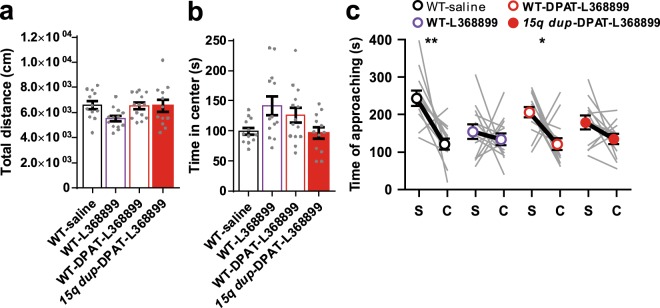Figure 4.
Effects of postnatal L-368,899 treatment on behavior in adult mice. (a) Total distance in OF test. There was no significant difference in the total distance traveled among groups (one-way ANOVA: F3,47 = 2.488, p = 0.072; Dunnett’s test). (b) Time spent in the center area in the OF test. There was no significant difference in the center time among groups. (one-way ANOVA: F3,47 = 3.418, p = 0.025; Steel’s test) (c) Time taken to approach to the stranger cage (S) and the empty cage (C) in 3-CSI test. Under the treatment with L-368,899, WT or 8OH-DPAT-treated 15q dup mice showed no significant difference between the time spent around the stranger mouse and the empty cage (WT-saline: t11 = 3.937, p = 0.002, Cohen’s d = 1.96; WT-L368899: t12 = 0.623, p = 0.545, Cohen’s d = 0.31; WT-DPAT-L368899: t13 = 2.948, p = 0.011, Cohen’s d = 1.50; 15q dup-DPAT-L368899: t11 = 1.805, p = 0.098, Cohen’s d = 0.80; paired t-test). The numbers of mice tested and their litters (mice/litters) in each group are as follows. WT-saline (12/5), WT-L368899 (13/4), WT-DPAT-L368899 (14/4), 15q dup-DPAT-L368899 (12/4). Data represent the mean ± SEM. *p < 0.05, **p < 0.01.

